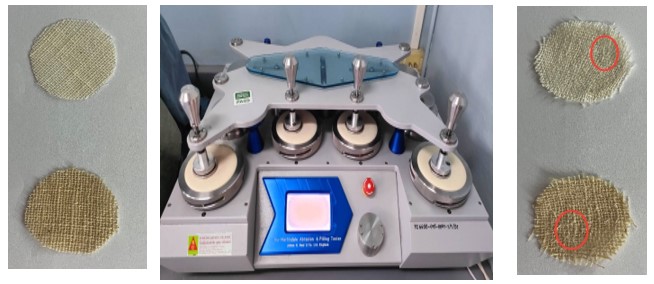Development of the Organic Cotton Clothing for Infants
Main Article Content
Abstract
This research aims to study the design of cotton clothing and reusable diapers for infants, the making of prototypes, analysis, and testing of fiber and fabric quality. The result of physical examination found that micronaire is 5, yarn strength is 2.41 gf/tex, and wetting time is more than 60 seconds by AATCC TM 79:2007 standard, which absorbency is very good level. The abrasion resistance by ISO12947 Part 2 1998 standard is 5000 loops and pilling can reach at level 5. Chemical examination found pH of 6.79, and no detection of heavy metals, which is suitable for manufacturing infant clothing by ISO 105-E04:1994/APHA:2005. From this research, organic cotton fiber is suitable for infant clothing manufacture without harmful chemical contamination. Organic cotton clothing is also soft feeling, good absorbency, and reduce irritation from synthetic fabric allergy in infants, which is good for tropical climate of Thailand. The organic cotton agriculture also reduces pollutions from chemical use, create more safety for cotton farmers, and protect the environment. Reusable diapers help climate changes by reducing waste from disposable diapers. Therefore, this design of organic cotton clothing for infant is an easy, safe and promising for commercial use.
Article Details
References
ธนพรรณ บุณยรัตกลิน. (2562). เทคนิคการแต่งกายด้วยตนเอง. วารสารเทคโนโลยีคหกรรมศาสตร์ มหาวิทยาลัยเทคโนโลยีราชมงคลพระนคร, 1(1), 72-77.
นวลแข ปาลิวนิช. (2556). ความรู้เรื่องผ้าและเส้นใย (ฉบับปรับปรุงใหม่). ซีเอ็ดยูเคชั่น, 33-37.
มุขสุดา ทองกำพร้า เกศทิพย์ กรี่เงิน และอัชชา หัทยานานนท์. (2563). การออกแบบเสื้อชุดลำลองยูนิเซ็กส์จากผ้าพลีทสำหรับวัยรุ่น. วารสารเทคโนโลยีคหกรรมศาสตร์ มหาวิทยาลัยเทคโนโลยีราชมงคลพระนคร, 2(2), 83-95.
รสนันท์ ศิริธรรมปิติ. (2552). การศึกษาคุณสมบัติทางกายภาพและสารปนเปื้อนในวัสดุสิ่งทอ กรณีศึกษาเส้นใยฝ้ายอินทรีย์เปรียบเทียบกับเส้นใยฝ้ายเคมี. [วิทยานิพนธ์ปริญญามหาบัณฑิต]. มหาวิทยาลัยเทคโนโลยีราชมงคลธัญบุรี.
สวรรค์ มณีโชติ และดุสิต อธินุวัฒน์. (2562). ปัจจัยที่ส่งผลต่อความสำเร็จของเกษตรอินทรีย์ในชุมชนเกษตรกรรายย่อย จังหวัดนครสวรรค์. Thai Journal of Science and Technology (TJST), 8(6), 596-608.
Measuring Fashion: Environmental Impact of the Global Apparel and Footwear Industries. (2023, March 18). http://quantis-intl.com/wp-content/uploads/2018/03/measuringfashion_ globalimpactstudy_full-report_quantis_ cwf_2018a.pdf.

